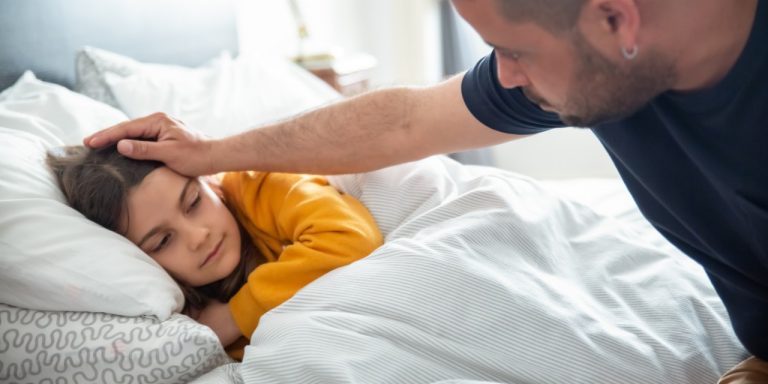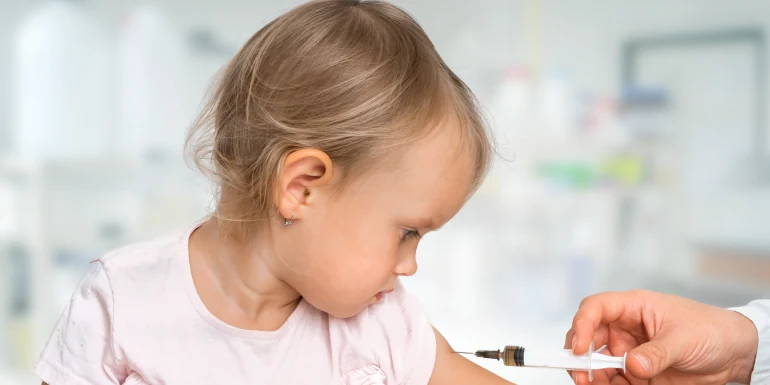
Mumps: symptoms and treatment
Is mumps dangerous? And is mumps infectious for adults too? What alleviates the symptoms of mumps? Find out all about mumps in babies, small children and adults.
What is mumps?
Mumps is defined as a childhood disease, and it is highly contagious. But how is mumps transmitted? Mumps viruses are spread primarily by droplet infection; infected droplets are released into the air through coughing, sneezing or talking, and other people can breathe them in. How can you prevent mumps?
The MMR vaccine is an effective way of preventing mumps. Not only does this vaccination protect children and adults from mumps, it also offers protection from the childhood diseases measles and rubella. Since 2023 the Federal Office of Public Health recommends combining this with vaccination against chickenpox (MMRV) for children aged between nine and twelve months as well as for adults born in 1964 or later.
What are the symptoms of mumps in children?
The symptoms of mumps aren’t always obvious. Toddlers under the age of five are more likely to experience flu-like symptoms. And unlike measles or rubella, mumps does not cause a rash. Mumps symptoms for parents to look out for include:
- Fever: Initial signs may include a mild to moderate fever that comes on suddenly. This is a common symptom of many childhood diseases, including mumps.
- Feeling unwell and loss of appetite: Children often feel generally unwell and show little interest in food. This symptom can occur along with other signs of infection.
- Painful swelling of the parotid glands: One obvious symptom of mumps is inflammation of the parotid glands, which leads to visible swelling in the facial area.
- Headaches: Headaches are another common symptom.
- Flu-like symptoms: Mumps can also cause flu-like symptoms, such as a cough, sore throat, fatigue, and a runny nose.
- Swelling of the salivary glands: In addition to the parotid glands, the salivary glands under the tongue and in the lower jaw can swell.
- Enlarged lymph nodes: In some cases, mumps can lead to enlarged lymph nodes.
On top of these symptoms, in rare cases childhood mumps can lead to complications like meningitis. But you should still check your child for symptoms, which can include severe headaches, neck stiffness and lethargy. If you notice these signs, contact your doctor immediately.
The symptoms of mumps are usually more pronounced in adults. The risk of long-term effects is also considerably greater in adults than in children. The symptoms of adult mumps vary depending on gender:
- Mumps in men: Mumps results in (usually) one-sided testicular inflammation in 15 to 30% of cases. Although many cases heal without long-term consequences, there is a small risk of infertility (sterility). There is also a possibility of mumps resulting in impotency.
- Mumps in women: Mumps can have various long-term effects in women. About 30% of women develop mammary gland inflammation and about 5% ovarian inflammation. This means mumps can disrupt fertility and lead to sterility in women, although this is rare.
How does mumps progress?
The duration and course of mumps can vary depending on the severity of the symptoms. The incubation period for mumps is generally 14 to 24 days. There are no symptoms during this time, but the virus is already active in the body. After the incubation period, initial symptoms appear, such as headaches and a sense of being generally unwell. One to two days later, the parotid gland swells. This swelling is initially one-sided, but later often affects both sides. This lasts around three to eight days.
How long is mumps infectious?
Someone with mumps will usually be contagious for two to seven days before the first symptoms appear. Once the disease has subsided, they are still contagious for up to nine days.
Can you get mumps more than once?
Mumps can recur in very rare cases, but generally infection confers lifelong immunity.
Is mumps dangerous for babies or pregnant women?
Mumps is the same in babies as it is in toddlers. However, particular caution is advised in pregnancy. Mumps can lead to miscarriage in the first three months of pregnancy, but the disease is not generally associated with later miscarriages or deformities.
Spotting mumps: how is mumps diagnosed?
There are a variety of methods for accurately diagnosing mumps in children and adolescents. These include:
- Visual diagnosis: The doctor examines the visible symptoms typically associated with mumps. Often they will be able to make an initial diagnosis based on the symptoms and the signs. Since the disease is rare, they will often arrange a laboratory test as well – especially if the patient has already been vaccinated against mumps.
- Laboratory diagnosis: A blood test is used to confirm the diagnosis. Here, specialists look for special antibodies: IgM antibodies (immunoglobulin M antibodies), which are indicators of infection.
- Further examinations: If these two examinations fail to yield meaningful results, a urine test or a throat swab can help.
Treatment of mumps in children – what helps?
Mumps can only be treated symptomatically, so treatment aims to alleviate the symptoms. The following tips can help:
- Rest up: Rest is important as it allows the body to fight the virus. Let your child recover from mumps at home – until the acute symptoms have subsided.
- Reduce fever: Calf compresses and suitable medication can help with a fever. Talk to your paediatrician about active ingredients and dosage.
- Keep hydrated: It is important that your child drink plenty of fluids, especially if they have a fever. Water and tea maintain help fluid levels and can alleviate difficulties in swallowing.
- Use compresses: Compresses help to combat swelling of the salivary glands and pain. You can choose between warming or cooling compresses – whichever is more comfortable for your child.
Mumps is usually harmless in children. If your child’s condition deteriorates in spite of treatment, contact your paediatric practice.

The expert provided the editorial team with expert advice and input for this article. Simeon Zürcher (PhD in Epidemiology and Biostatistics) works as a researcher in the Public Health Sciences team at Helsana.


Newsletter
Find out more about current health issues every month and get all the information you need about our attractive offers from all Helsana Group companies * delivered by e-mail to read whenever it suits you. Our newsletter is free of charge and you can sign up here:
We did not receive your information. Please try again later.
* The Helsana Group comprises Helsana Insurance Company Ltd, Helsana Supplementary Insurances Ltd and Helsana Accidents Ltd.